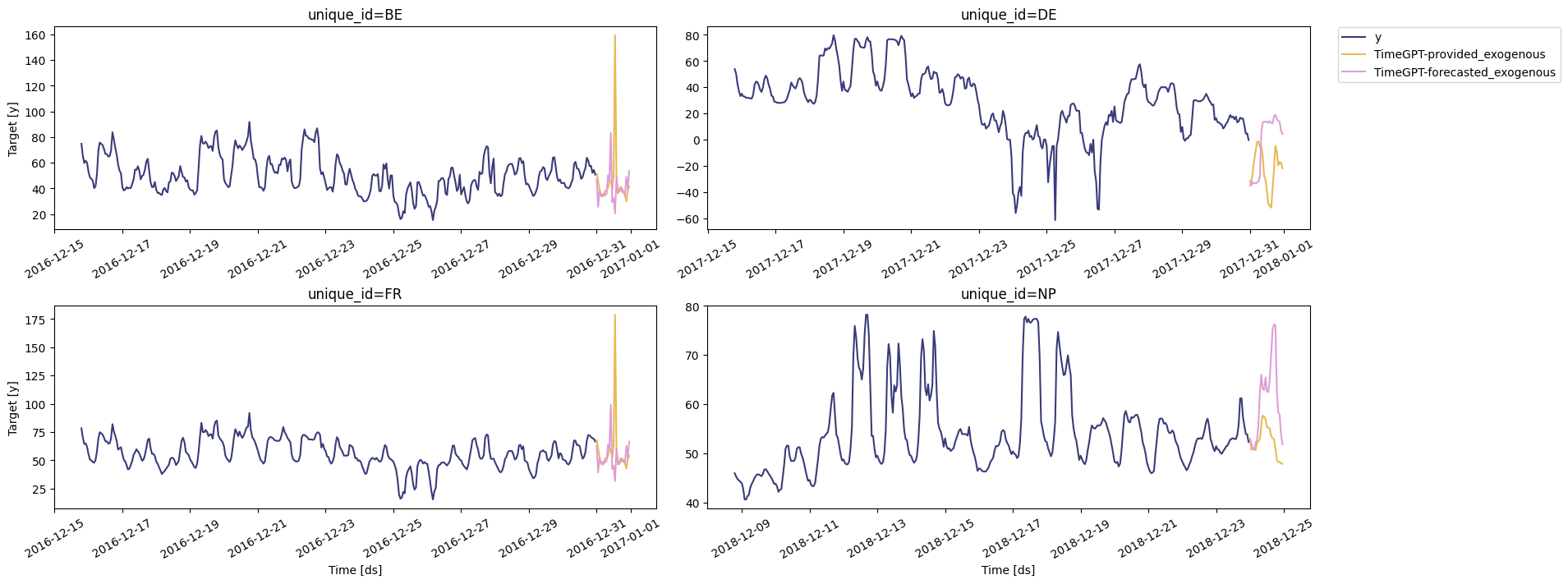1. Import packages
First, we import the required packages and initialize the Nixtla client.👍 Use an Azure AI endpoint To use an Azure AI endpoint, remember to set also thebase_urlargument:nixtla_client = NixtlaClient(base_url="you azure ai endpoint", api_key="your api_key")
2. Load data
Let’s see an example on predicting day-ahead electricity prices. The following dataset contains the hourly electricity price (y column) for
five markets in Europe and US, identified by the unique_id column. The
columns from Exogenous1 to day_6 are exogenous variables that
TimeGPT will use to predict the prices.
| unique_id | ds | y | Exogenous1 | Exogenous2 | day_0 | day_1 | day_2 | day_3 | day_4 | day_5 | day_6 | |
|---|---|---|---|---|---|---|---|---|---|---|---|---|
| 0 | BE | 2016-10-22 00:00:00 | 70.00 | 57253.0 | 49593.0 | 0.0 | 0.0 | 0.0 | 0.0 | 0.0 | 1.0 | 0.0 |
| 1 | BE | 2016-10-22 01:00:00 | 37.10 | 51887.0 | 46073.0 | 0.0 | 0.0 | 0.0 | 0.0 | 0.0 | 1.0 | 0.0 |
| 2 | BE | 2016-10-22 02:00:00 | 37.10 | 51896.0 | 44927.0 | 0.0 | 0.0 | 0.0 | 0.0 | 0.0 | 1.0 | 0.0 |
| 3 | BE | 2016-10-22 03:00:00 | 44.75 | 48428.0 | 44483.0 | 0.0 | 0.0 | 0.0 | 0.0 | 0.0 | 1.0 | 0.0 |
| 4 | BE | 2016-10-22 04:00:00 | 37.10 | 46721.0 | 44338.0 | 0.0 | 0.0 | 0.0 | 0.0 | 0.0 | 1.0 | 0.0 |
3a. Forecasting electricity prices using future exogenous variables
To produce forecasts with future exogenous variables we have to add the future values of the exogenous variables. Let’s read this dataset. In this case, we want to predict 24 steps ahead, therefore eachunique_id
will have 24 observations.
| unique_id | ds | Exogenous1 | Exogenous2 | day_0 | day_1 | day_2 | day_3 | day_4 | day_5 | day_6 | |
|---|---|---|---|---|---|---|---|---|---|---|---|
| 0 | BE | 2016-12-31 00:00:00 | 70318.0 | 64108.0 | 0.0 | 0.0 | 0.0 | 0.0 | 0.0 | 1.0 | 0.0 |
| 1 | BE | 2016-12-31 01:00:00 | 67898.0 | 62492.0 | 0.0 | 0.0 | 0.0 | 0.0 | 0.0 | 1.0 | 0.0 |
| 2 | BE | 2016-12-31 02:00:00 | 68379.0 | 61571.0 | 0.0 | 0.0 | 0.0 | 0.0 | 0.0 | 1.0 | 0.0 |
| 3 | BE | 2016-12-31 03:00:00 | 64972.0 | 60381.0 | 0.0 | 0.0 | 0.0 | 0.0 | 0.0 | 1.0 | 0.0 |
| 4 | BE | 2016-12-31 04:00:00 | 62900.0 | 60298.0 | 0.0 | 0.0 | 0.0 | 0.0 | 0.0 | 1.0 | 0.0 |
forecast method, adding this information:
| unique_id | ds | TimeGPT | TimeGPT-hi-80 | TimeGPT-hi-90 | TimeGPT-lo-80 | TimeGPT-lo-90 | |
|---|---|---|---|---|---|---|---|
| 0 | BE | 2016-12-31 00:00:00 | 51.632830 | 61.598820 | 66.088295 | 41.666843 | 37.177372 |
| 1 | BE | 2016-12-31 01:00:00 | 45.750877 | 54.611988 | 60.176445 | 36.889767 | 31.325312 |
| 2 | BE | 2016-12-31 02:00:00 | 39.650543 | 46.256210 | 52.842808 | 33.044876 | 26.458277 |
| 3 | BE | 2016-12-31 03:00:00 | 34.000072 | 44.015310 | 47.429000 | 23.984835 | 20.571144 |
| 4 | BE | 2016-12-31 04:00:00 | 33.785370 | 43.140503 | 48.581240 | 24.430239 | 18.989498 |
📘 Available models in Azure AI If you are using an Azure AI endpoint, please be sure to setmodel="azureai":nixtla_client.forecast(..., model="azureai")For the public API, we support two models:timegpt-1andtimegpt-1-long-horizon. By default,timegpt-1is used. Please see this tutorial on how and when to usetimegpt-1-long-horizon.
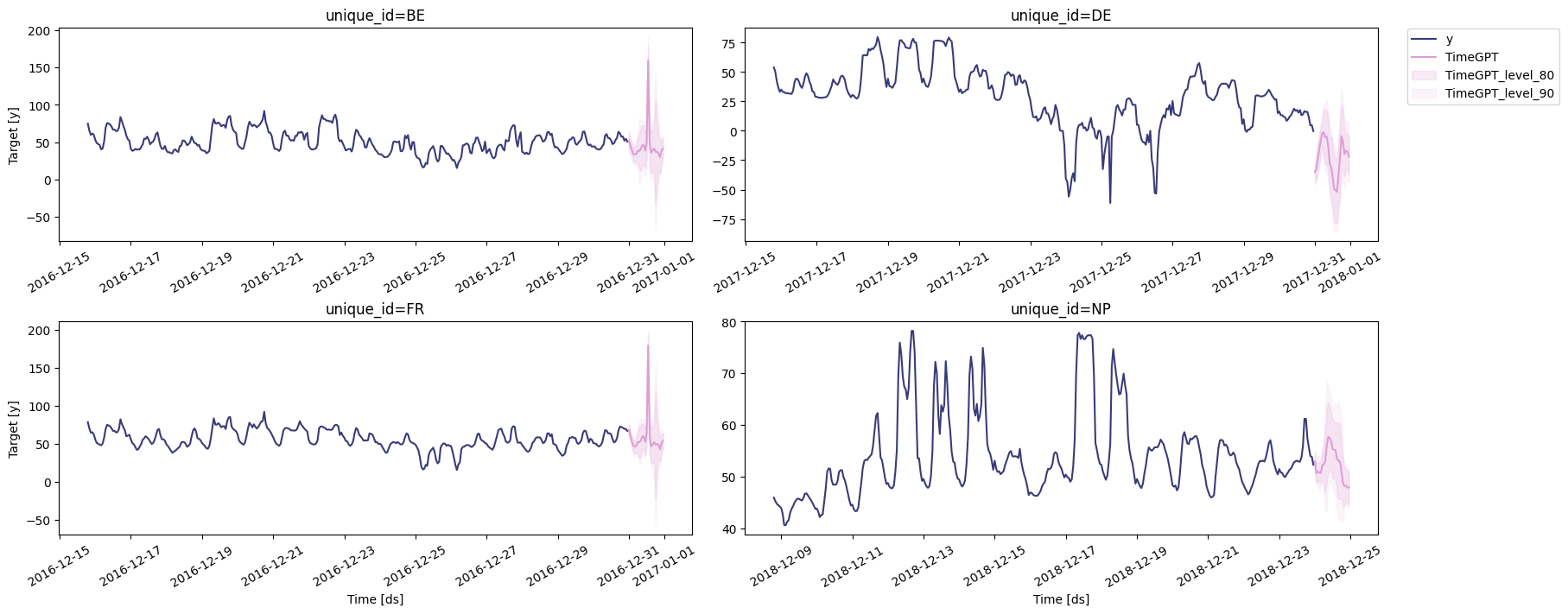
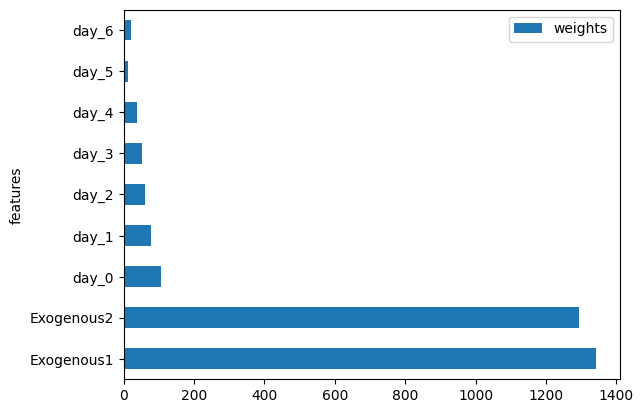
Exogenous1 and Exogenous2 are the most
important for this forecasting task, as they have the largest weight.
3b. Forecasting electricity prices using historic exogenous variables
In the example above, we just loaded the future exogenous variables. Often, these are not available because these variables are unknown. We can also make forecasts using only historic exogenous variables. This can be done by adding thehist_exog_list argument with the list of
columns of df to be considered as historical. In that case, we can
pass all extra columns available in df as historic exogenous variables
using
hist_exog_list=['Exogenous1', 'Exogenous2', 'day_0', 'day_1', 'day_2', 'day_3', 'day_4', 'day_5', 'day_6'].
Important If you include historic exogenous variables in your model, you are implicitly making assumptions about the future of these exogenous variables in your forecast. It is recommended to make these assumptions explicit by making use of future exogenous variables.Let’s call the
forecast method, adding hist_exog_list:
| unique_id | ds | TimeGPT | TimeGPT-hi-80 | TimeGPT-hi-90 | TimeGPT-lo-80 | TimeGPT-lo-90 | |
|---|---|---|---|---|---|---|---|
| 0 | BE | 2016-12-31 00:00:00 | 47.311330 | 57.277317 | 61.766790 | 37.345340 | 32.855870 |
| 1 | BE | 2016-12-31 01:00:00 | 47.142740 | 56.003850 | 61.568306 | 38.281628 | 32.717170 |
| 2 | BE | 2016-12-31 02:00:00 | 47.311474 | 53.917137 | 60.503740 | 40.705810 | 34.119210 |
| 3 | BE | 2016-12-31 03:00:00 | 47.224514 | 57.239750 | 60.653442 | 37.209280 | 33.795586 |
| 4 | BE | 2016-12-31 04:00:00 | 47.266945 | 56.622078 | 62.062817 | 37.911810 | 32.471073 |
📘 Available models in Azure AI If you are using an Azure AI endpoint, please be sure to setmodel="azureai":nixtla_client.forecast(..., model="azureai")For the public API, we support two models:timegpt-1andtimegpt-1-long-horizon. By default,timegpt-1is used. Please see this tutorial on how and when to usetimegpt-1-long-horizon.
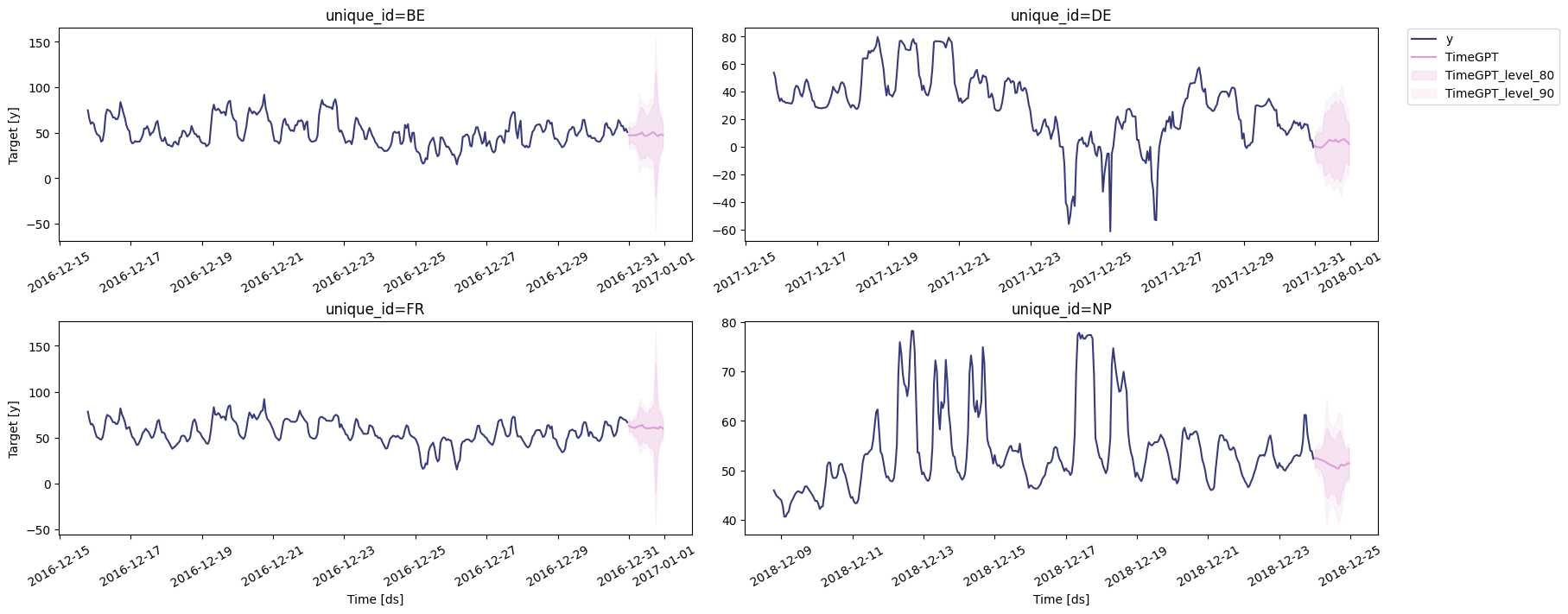
3c. Forecasting electricity prices using future and historic exogenous variables
A third option is to use both historic and future exogenous variables. For example, we might not have available the future information forExogenous1 and Exogenous2. In this example, we drop these variables
from our future exogenous dataframe (because we assume we do not know
the future value of these variables), and add them to hist_exog_list
to be considered as historical exogenous variables.
📘 Available models in Azure AI If you are using an Azure AI endpoint, please be sure to setmodel="azureai":nixtla_client.forecast(..., model="azureai")For the public API, we support two models:timegpt-1andtimegpt-1-long-horizon. By default,timegpt-1is used. Please see this tutorial on how and when to usetimegpt-1-long-horizon.
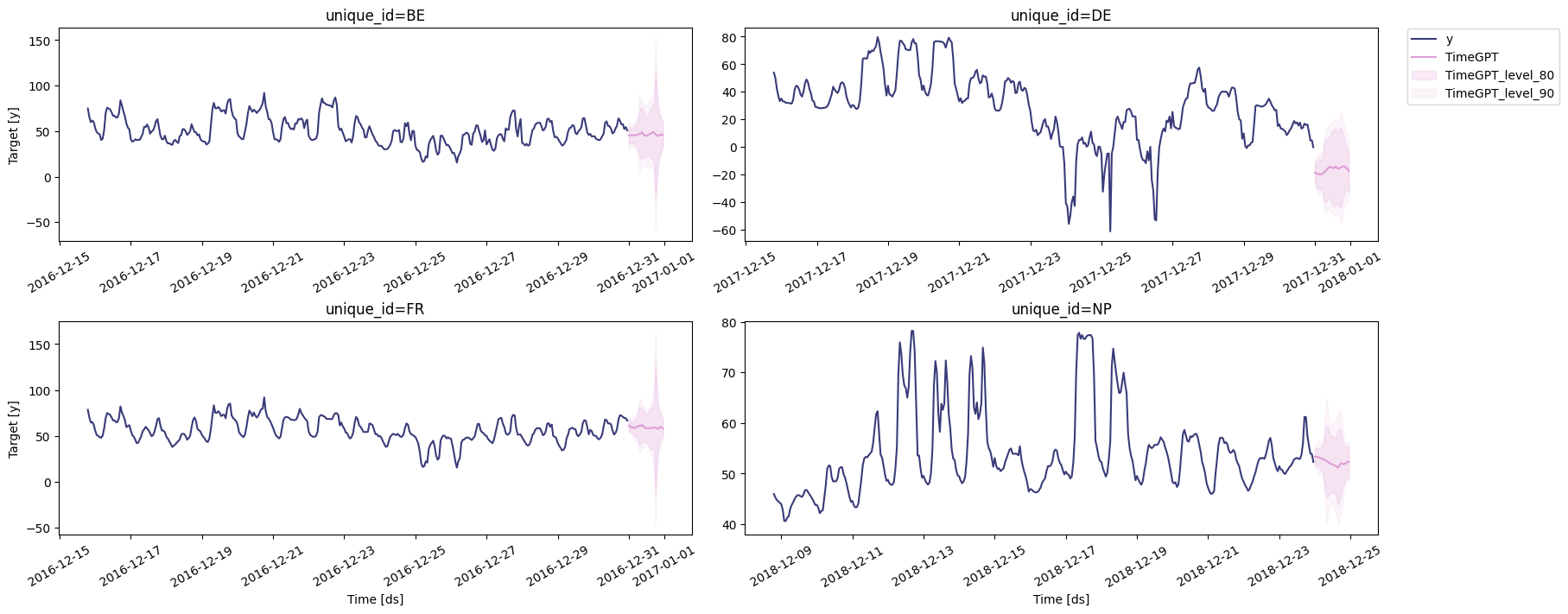
3d. Forecasting future exogenous variables
A fourth option in case the future exogenous variables are not available is to forecast them. Below, we’ll show you how we can also forecastExogenous1 and Exogenous2 separately, so that you can generate the
future exogenous variables in case they are not available.
Exogenous1 and Exogenous2. In
this case, we assume these quantities can be separately forecast.
📘 Available models in Azure AI If you are using an Azure AI endpoint, please be sure to setWe can now start creatingmodel="azureai":nixtla_client.forecast(..., model="azureai")For the public API, we support two models:timegpt-1andtimegpt-1-long-horizon. By default,timegpt-1is used. Please see this tutorial on how and when to usetimegpt-1-long-horizon.
X_df, which contains the future exogenous
variables.
day_0 to day_6 future exogenous
variables. These are easy: this is just the weekday, which we can
extract from the ds column.
X_df, let’s investigate it:
| unique_id | ds | Exogenous1 | Exogenous2 | day_0 | day_1 | day_2 | day_3 | day_4 | day_5 | day_6 | |
|---|---|---|---|---|---|---|---|---|---|---|---|
| 0 | BE | 2016-12-31 00:00:00 | 70861.410 | 66282.560 | 0 | 0 | 0 | 0 | 0 | 1 | 0 |
| 1 | BE | 2016-12-31 01:00:00 | 67851.830 | 64465.370 | 0 | 0 | 0 | 0 | 0 | 1 | 0 |
| 2 | BE | 2016-12-31 02:00:00 | 67246.660 | 63257.117 | 0 | 0 | 0 | 0 | 0 | 1 | 0 |
| 3 | BE | 2016-12-31 03:00:00 | 64027.203 | 62059.316 | 0 | 0 | 0 | 0 | 0 | 1 | 0 |
| 4 | BE | 2016-12-31 04:00:00 | 61524.086 | 61247.062 | 0 | 0 | 0 | 0 | 0 | 1 | 0 |
| 5 | BE | 2016-12-31 05:00:00 | 63054.086 | 62052.312 | 0 | 0 | 0 | 0 | 0 | 1 | 0 |
| 6 | BE | 2016-12-31 06:00:00 | 65199.473 | 63457.720 | 0 | 0 | 0 | 0 | 0 | 1 | 0 |
| 7 | BE | 2016-12-31 07:00:00 | 68285.770 | 65388.656 | 0 | 0 | 0 | 0 | 0 | 1 | 0 |
| 8 | BE | 2016-12-31 08:00:00 | 72038.484 | 67406.836 | 0 | 0 | 0 | 0 | 0 | 1 | 0 |
| 9 | BE | 2016-12-31 09:00:00 | 72821.190 | 68057.240 | 0 | 0 | 0 | 0 | 0 | 1 | 0 |
| unique_id | ds | Exogenous1 | Exogenous2 | day_0 | day_1 | day_2 | day_3 | day_4 | day_5 | day_6 | |
|---|---|---|---|---|---|---|---|---|---|---|---|
| 0 | BE | 2016-12-31 00:00:00 | 70318.0 | 64108.0 | 0.0 | 0.0 | 0.0 | 0.0 | 0.0 | 1.0 | 0.0 |
| 1 | BE | 2016-12-31 01:00:00 | 67898.0 | 62492.0 | 0.0 | 0.0 | 0.0 | 0.0 | 0.0 | 1.0 | 0.0 |
| 2 | BE | 2016-12-31 02:00:00 | 68379.0 | 61571.0 | 0.0 | 0.0 | 0.0 | 0.0 | 0.0 | 1.0 | 0.0 |
| 3 | BE | 2016-12-31 03:00:00 | 64972.0 | 60381.0 | 0.0 | 0.0 | 0.0 | 0.0 | 0.0 | 1.0 | 0.0 |
| 4 | BE | 2016-12-31 04:00:00 | 62900.0 | 60298.0 | 0.0 | 0.0 | 0.0 | 0.0 | 0.0 | 1.0 | 0.0 |
| 5 | BE | 2016-12-31 05:00:00 | 62364.0 | 60339.0 | 0.0 | 0.0 | 0.0 | 0.0 | 0.0 | 1.0 | 0.0 |
| 6 | BE | 2016-12-31 06:00:00 | 64242.0 | 62576.0 | 0.0 | 0.0 | 0.0 | 0.0 | 0.0 | 1.0 | 0.0 |
| 7 | BE | 2016-12-31 07:00:00 | 65884.0 | 63732.0 | 0.0 | 0.0 | 0.0 | 0.0 | 0.0 | 1.0 | 0.0 |
| 8 | BE | 2016-12-31 08:00:00 | 68217.0 | 66235.0 | 0.0 | 0.0 | 0.0 | 0.0 | 0.0 | 1.0 | 0.0 |
| 9 | BE | 2016-12-31 09:00:00 | 69921.0 | 66801.0 | 0.0 | 0.0 | 0.0 | 0.0 | 0.0 | 1.0 | 0.0 |
Exogenous1 and Exogenous2 are
slightly different, which makes sense because we’ve made a forecast of
these values with TimeGPT.
Let’s create a new forecast of our electricity prices with TimeGPT using
our new X_df:
| unique_id | ds | TimeGPT | TimeGPT-hi-80 | TimeGPT-hi-90 | TimeGPT-lo-80 | TimeGPT-lo-90 | |
|---|---|---|---|---|---|---|---|
| 0 | BE | 2016-12-31 00:00:00 | 46.987225 | 56.953213 | 61.442684 | 37.021236 | 32.531765 |
| 1 | BE | 2016-12-31 01:00:00 | 25.719133 | 34.580242 | 40.144700 | 16.858023 | 11.293568 |
| 2 | BE | 2016-12-31 02:00:00 | 38.553528 | 45.159195 | 51.745792 | 31.947860 | 25.361261 |
| 3 | BE | 2016-12-31 03:00:00 | 35.771927 | 45.787163 | 49.200855 | 25.756690 | 22.342999 |
| 4 | BE | 2016-12-31 04:00:00 | 34.555115 | 43.910248 | 49.350986 | 25.199984 | 19.759243 |
📘 Available models in Azure AI If you are using an Azure AI endpoint, please be sure to setLet’s create a combined dataframe with the two forecasts and plot the values to compare the forecasts.model="azureai":nixtla_client.forecast(..., model="azureai")For the public API, we support two models:timegpt-1andtimegpt-1-long-horizon. By default,timegpt-1is used. Please see this tutorial on how and when to usetimegpt-1-long-horizon.
